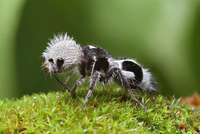
Photo from wikipedia
The importance of vision-reliant defensive traits (e.g. warning colours) in mimicry studies is well established, but their effectiveness is limited by visibility. In low light conditions, for instance, acoustic or… Click to show full abstract
The importance of vision-reliant defensive traits (e.g. warning colours) in mimicry studies is well established, but their effectiveness is limited by visibility. In low light conditions, for instance, acoustic or tactile channels may be more effective. The juvenile and adult stages of the nocturnal hunting Palpimanus spiders audibly stridulate when harassed. Given this we hypothesized that the sound produced by Palpimanus has a defensive role against interspecific predators. Palpimanus though are poorly defended especially against something as large as a gecko. Hence we hypothesized that the stridulation is effective because the spider mimics co-occurring mutillid wasps. We staged predator feeding experiments in which mutillid wasps, sham-operated Palpimanus, silenced Palpimanus and a nonstridulating spider were offered to Eusparassus spiders and geckoes. Stridulating spiders had significantly greater survival against both predators than the nonstridulating treatments and comparable survival to the mutillid wasps. This result represents the first confirmed case of a spider using stridulation against an interspecific predator. Stridulation deterred Eusparasus spiders, while in geckoes stridulation acted postcapture as they dropped the prey instead of attempting to swallow them. For mutillid wasps this dropping response was typically more rapid than with Palpimanus but attempts to swallow silenced individuals were more frequent than sham-operated individuals, which were more likely to be dropped before any attempt to swallow. Analyses of stridulation characteristics of Palpimanus showed they were similar to acoustic signals of four of the co-occurring mutillid wasps and far more so than distress signals of control insects. Our study overall supports the notion that Palpimanus spiders are Batesian mimics of sympatrically occurring mutillids through the use of an aposematic acoustic signal and not just an example of a startle response.
Journal Title: Animal Behaviour
Year Published: 2020
Link to full text (if available)
Share on Social Media: Sign Up to like & get
recommendations!